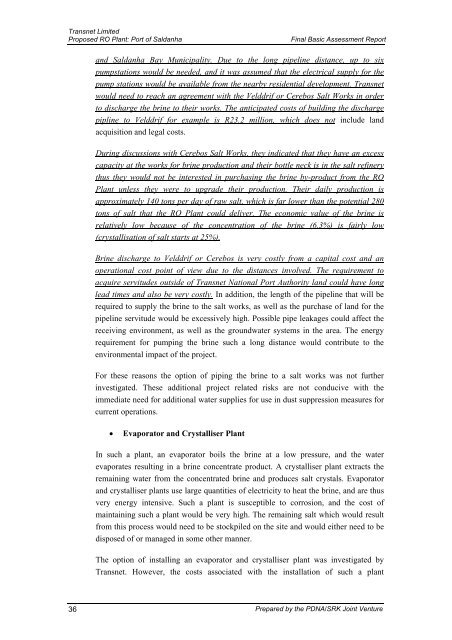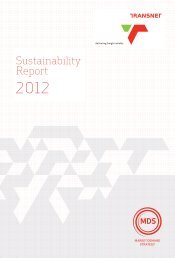Basic Assessment Report - Transnet
Basic Assessment Report - Transnet
Basic Assessment Report - Transnet
Create successful ePaper yourself
Turn your PDF publications into a flip-book with our unique Google optimized e-Paper software.
<strong>Transnet</strong> LimitedProposed RO Plant: Port of SaldanhaFinal <strong>Basic</strong> <strong>Assessment</strong> <strong>Report</strong>and Saldanha Bay Municipality. Due to the long pipeline distance, up to sixpumpstations would be needed, and it was assumed that the electrical supply for thepump stations would be available from the nearby residential development. <strong>Transnet</strong>would need to reach an agreement with the Velddrif or Cerebos Salt Works in orderto discharge the brine to their works. The anticipated costs of building the dischargepipline to Velddrif for example is R23.2 million, which does not include landacquisition and legal costs.During discussions with Cerebos Salt Works, they indicated that they have an excesscapacity at the works for brine production and their bottle neck is in the salt refinerythus they would not be interested in purchasing the brine by-product from the ROPlant unless they were to upgrade their production. Their daily production isapproximately 140 tons per day of raw salt, which is far lower than the potential 280tons of salt that the RO Plant could deliver. The economic value of the brine isrelatively low because of the concentration of the brine (6.3%) is fairly low(crystallisation of salt starts at 25%).Brine discharge to Velddrif or Cerebos is very costly from a capital cost and anoperational cost point of view due to the distances involved. The requirement toacquire servitudes outside of <strong>Transnet</strong> National Port Authority land could have longlead times and also be very costly. In addition, the length of the pipeline that will berequired to supply the brine to the salt works, as well as the purchase of land for thepipeline servitude would be excessively high. Possible pipe leakages could affect thereceiving environment, as well as the groundwater systems in the area. The energyrequirement for pumping the brine such a long distance would contribute to theenvironmental impact of the project.For these reasons the option of piping the brine to a salt works was not furtherinvestigated. These additional project related risks are not conducive with theimmediate need for additional water supplies for use in dust suppression measures forcurrent operations.• Evaporator and Crystalliser PlantIn such a plant, an evaporator boils the brine at a low pressure, and the waterevaporates resulting in a brine concentrate product. A crystalliser plant extracts theremaining water from the concentrated brine and produces salt crystals. Evaporatorand crystalliser plants use large quantities of electricity to heat the brine, and are thusvery energy intensive. Such a plant is susceptible to corrosion, and the cost ofmaintaining such a plant would be very high. The remaining salt which would resultfrom this process would need to be stockpiled on the site and would either need to bedisposed of or managed in some other manner.The option of installing an evaporator and crystalliser plant was investigated by<strong>Transnet</strong>. However, the costs associated with the installation of such a plant36Prepared by the PDNA/SRK Joint Venture
















